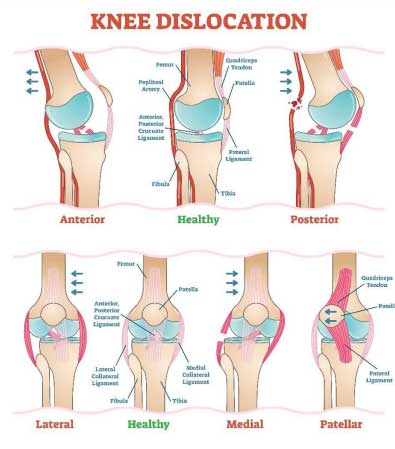Knee Dislocation: Causes, Signs and Symptoms, Treatment, and Prognosis. Are you a Golden State Warriors fan? Do you remember Shaun Livingston, the greatest backup point guard to Steph Curry from 2014-2018? Did you know he suffered two dislocated knees during the early years of his NBA career? What was thought to be a career ending injury occurred on February 26, 2007.
Shaun Livingston, then a member of the L.A. Clippers, was playing in a game against the Charlotte Bobcats. On a breakaway steal for an easy layup, Shaun jumped up to make the layup and landed awkwardly in pain onto his distorted bent left leg. The result was one of the most gruesome injuries seen
in sports. In addition to tearing his ACL, PCL, MCL, and lateral meniscus, he dislocated both kneecaps and
tibiofemoral joints. Shaun wasn’t expected to make a return to the NBA; however, with a combination of
highly skilled physicians, surgeons and physical therapists caring for him–coupled with Shaun’s determination to overcome such a devastating, career-ending injury–he returned to the NBA 20 months
later to play with the Miami Heat. To learn more about knee dislocations, continue to read the information below.
What is a knee dislocation?
● Though a knee dislocation is a rare injury, its diagnosis is important as a lack of appropriate treatment may result in a loss of limb.
● A knee dislocation is a surgical medical emergency because of possible neurovascular complications due to prolonged ischemia or lack of blood circulating to the injured extremity.
● Complications may include injury to the popliteal artery and vein, peroneal nerve injury, and compartment syndrome.
● Three major ligament ruptures may occur because of the dislocation.
● Treatment for the dislocation begins immediately in the ER.
● For a good prognosis, physicians must ensure an accurate diagnosis through evaluation, imaging, and surgical consultation to determine the definitive treatment.
● A knee dislocation is different from a patellar dislocation because a knee dislocation does not require immediate surgery or vascular intervention.
Causes
● High energy trauma (Ex: motor vehicle collision (MVC), sports related injury, auto-pedestrian impact, industrial injuries, and major falls) causes the tibiofemoral dislocation at the knee.
o Multiple ligament injuries and instability will result.
o Posterior and anterior dislocations occur frequently.
o More than half of all dislocations (anterior or posterior or both) have a high rate of popliteal artery injury.
o Medial, lateral, and rotatory (major knee twist) are possible but are rare.
Signs and Symptoms
● A grossly deformed knee with swelling, immobility, and severe pain
● Fractures
Treatment
● Immediate emergency room care
● X-rays
● MRIs
● Angiography
Prognosis
● Treatment with importance and accuracy: 60-70% of patients will have painless and stable knee(s).
● Remaining patients (1/2) will eventually have a functional knee, and the other half will have chronic pain and instability.

References
Kelleher, B. & Mandavia, D. (2019). Knee Dislocation. https://emedicine.medscape.com/article/823589-overview
Mohseni, M. & Simon, L.V. (2022). Knee Dislocation. https://www.ncbi.nlm.nih.gov/books/NBK470595/
VectorMine. (2022). [Illustration]. Knee Dislocations. https://www.shutterstock.com/image-vector/knee-dislocations-medical-vector-illustration-diagrams-1016095543
